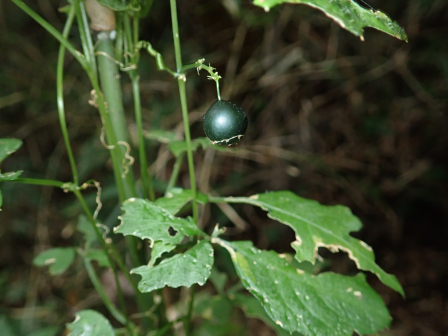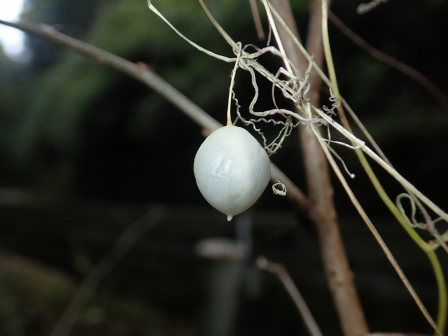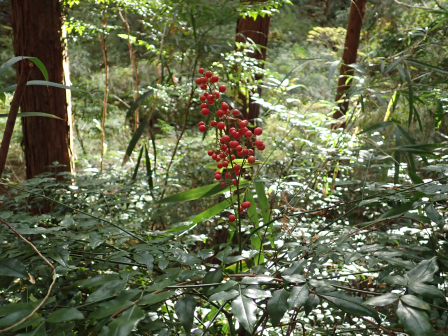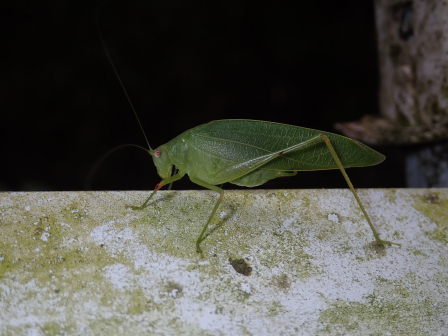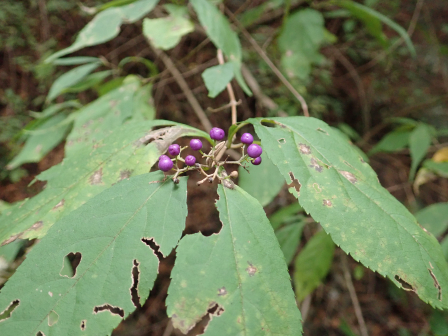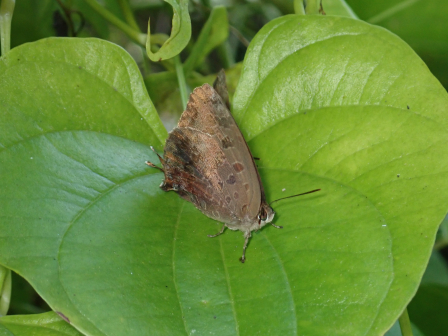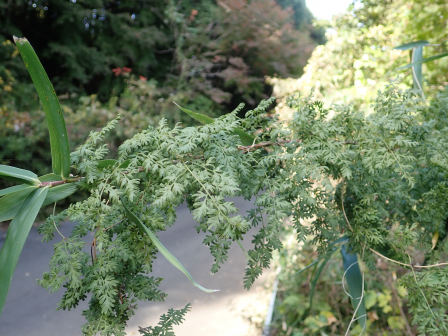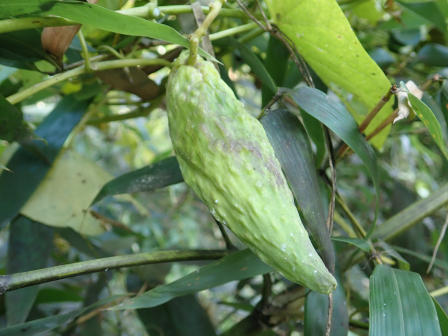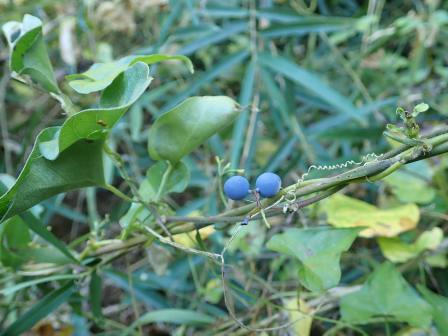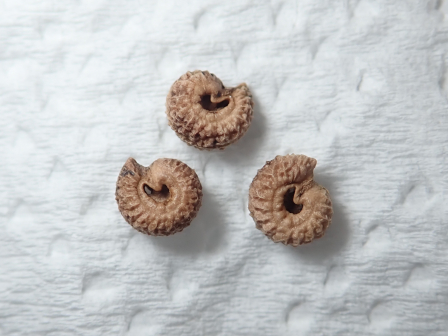フィールド日記
2021.12.14
アマチャヅル
裏道でアマチャヅルの果実を見つけました。萼や花弁の名残と思われる環状の模様があるのが特徴です。和名は葉に甘味があり、本種からつくったお茶の味が、アジサイの仲間のアマチャからつくったお茶に似ることが由来と言われています。(アマチャヅルの花のようすはこちら)
I found the fruit of "Amacha-Zuru (アマチャヅル)" on the back road. The fruit is characterized by the ring pattern on it, which is the remain of its calyx and petal. The name comes from the fact that their leaves are sweet and the tea made of their leaves tastes like the tea made of those of "Amacha (アマチャ)" plant, which belongs to the group of Hydrangea.
2021.12.10
スズメウリ
裏道でスズメウリの果実を見つけました。果実は1cmほどの球形で、はじめは緑色ですが、後に写真のように灰白色になります。和名のスズメウリは、カラスウリに対してより小型であることが由来のようです。
I found the fruit of "Suzume-Uri (スズメウリ)" plants on the back road. Their fruit is around 1 cm in diameter. They are green at first and turn ash-white later as you can see in the photo. The name "Suzume-Uri" means "sparrow-melon" and it comes from the fact that their fruit is smaller than the fruit of "Karasu-Uri (カラスウリ)" plants, whose name means "crow melon".
2021.12.07
ナンテン
ナンテンの実が赤く色づいています。関東以西に自生していますが、かつて中国から渡来した栽培品が逸出したものとも言われています。和名のナンテンが「難転、難を転ずる」に通ずることから縁起が良い木とされ、公園や庭木としてしばしば植栽されています。
The fruit of "Nanten (ナンテン)" trees has turned red. They live in the west of Kanto region, however, it's said that they derived from the cultivated trees that came from China in the past. The sound of their name can mean "turning difficulty into fortune" so they are regarded as a lucky tree. They are often planted in parks and gardens.
2021.12.03
ヒメクダマキモドキ
裏道でヒメクダマキモドキを見つけました。本州では海に近い温暖な地域の林縁などでよく見られる種で、最近では都市部の公園でも見ることが多いようです。特にアカメガシワを好んで食べるようです。
I found a "Hime-Kudamaki-Modoki (ヒメクダマキモドキ)" cricket on the back road. In the main island of Japan, they are often seen on the edge of forests in warm regions near the sea. It's said that they are seen even in parks in the city these days. They like to eat leaves of "Akame-Gashiwa (アカメガシワ)" trees.
2021.11.30
ムラサキシキブ
裏道でムラサキシキブが紫色の実をつけています。近縁種のコムラサキよりも大型で2~3mになり、実はややまばらにつきます。庭木としては小型で実付きのよいコムラサキのほうがよく見られますが、野生のものはほとんどムラサキシキブかヤブムラサキです。
I found the fruit of "Murasaki-Shikibu (ムラサキシキブ)" on the back road. Compared to a close relative species "Ko-Murasaki (コムラサキ)", they are larger growing up to 3 m in height and bear a little less fruit. "Ko-Murasaki" trees are more often seen in gardens because they are small and bear more fruit. However, in wild, almost all trees that belong to these similar species are "Murasaki-Shikibu" or "Yabu-Murasaki (ヤブムラサキ)".
2021.11.26
ムラサキツバメ
裏道を歩いていると、目の前を紫の金属光沢のある蝶が横切りました。追いかけて確認するとムラサキツバメでした。後翅に尾状突起があることが特徴で、和名のツバメはこの突起に由来します。近年数が増えていると言われている蝶で、都市部の公園等でも見ることができるようです。しばらく待っていましたが、残念ながら翅を開いて紫色の綺麗な金属光沢を見せてくれることはありませんでした。
Walking on the back road, I saw a shiny purple butterfly flying. I followed the butterfly and found out it was a "Murasaki-Tsubame (ムラサキツバメ)" butterfly. They have tails on their rear wings and "Tsubame (ツバメ)" in their name comes from these tails. It's said that their number is increasing these days, so you can see them even at parks in urban areas. The butterfly didn't open its wings or show the shiny purple on its wings, while I was waiting looking at it.
2021.11.23
カニクサ
カニクサが胞子をつけていました。シダ植物のなかまでは珍しくつる性です。茎が他の植物に巻き付きながら成長して葉を出しているように見えますが、実際は、地上に出た1枚の葉がつる状になって成長を続けています。
I found "Kanikusa" fern plants bearing spores. They are unique in that they are a vine plant even though they are a fern plant. It seems as if their stems grew winding other plants and sending out leaves. However, actually, one leaf, which looks like a stem, comes out from the ground growing like a vine.
2021.11.19
センニンソウ
裏道でセンニンソウの果実を見つけました。花の後、雌しべの花柱(かちゅう、柱頭と子房の間の部分)とその羽毛状の毛が伸びます。和名のセンニンは仙人を意味しており、この果実に生える羽毛状の毛を仙人の白髪に見立てたことに由来します。(センニンソウの花のようすはこちら)
I found the fruit of "Sennin-Sou (センニンソウ)" on the back road. After their flowering period, both their style, which is the part between their ovary and stigma, and their featherlike hair on it grow. “Sennin (センニン)” in its name means hermit and it comes from their featherlike hair on the fruit that looks like the hair of a hermit. (Click here to read an article about flowers of "Sennin-Sou").
2021.11.16
ガガイモ
駐車場近くのガガイモが果実をつけていました。6cm~10cmにもなる大型の果実で、表面にはいぼ状の突起があります。名前のイモは、地下に芋ができることを意味するのではなく、この果実に由来しています。(ガガイモの花のようすはこちら)
I found the fruit of "Gaga-Imo (ガガイモ)" plants near the parking area. The large fruit with warty surface grows up to 10 cm in length. "Imo (イモ)" in its name means "tuber". However, the name doesn't mean that they have tubers underground but that the name comes from this fruit looking like a tuber. (Click here to read an article about flowers of "Gaga-Imo").
2021.11.12
アオツヅラフジ
裏道でアオツヅラフジの果実を見つけました。ブルーベリーのような見た目でおいしそうですが、有毒なため食べることはできません。
また、果実の中の種子が、下の写真のようにアンモナイトの化石のように見えることで有名です。
I found the fruit of "Ao-Tsuzurafuji (アオツヅラフジ)" on the back road. They are similar to blueberries and look tasty, but they are not edible because they are poisonous. Their seeds inside the fruit are famous for the fact that they look like fossils of ammonites.


